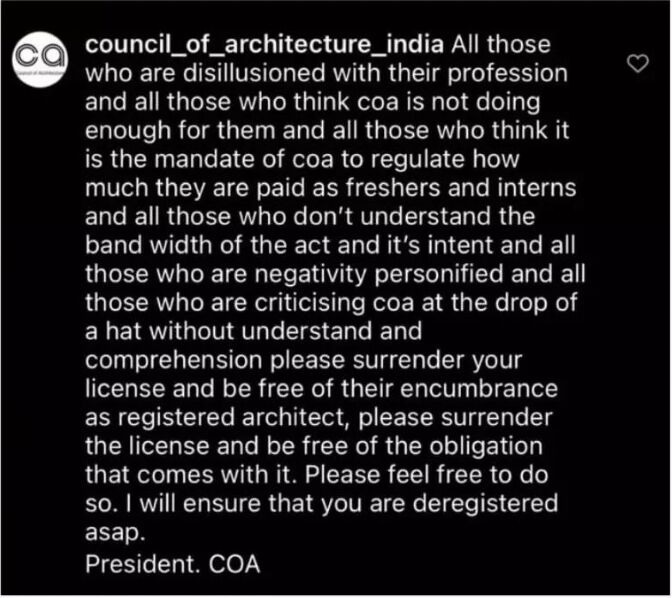The tenure of the current leadership of the Council of Architecture (CoA), under Mr Habeeb Khan as President and Ms Sapna as Vice-President, is coming to a close. This is an opportune moment to reflect on what the CoA is meant to be, especially given that this has been one of the most proactive leaderships of the CoA in recent memory. Key initiatives it has undertaken include:
- Responded to the 2020 judgment of the Supreme Court suggesting how the Architects Act of 1972 could be amended to replace the judgment’s narrow reading, whereby only the title of ‘Architect’ was protected, by a broader view of regulating the practice of architecture.
- Issued a major restructuring in 2020 of The Minimum Standards of Architectural Education, shifting from the over-specification of a semester-by-semester description to a choice-based credit system that increases flexibility and autonomy for schools and their students.
- Released a ‘Manual of Architectural Practice’ that offers benchmarks for managing a practice.
- Launched CoA Social, an interactive forum with four threads: Dialogues, Readings, Women in Architecture, and People.
- Formed a committee to tackle issues faced by women in architecture.
- Worked with the national institutions tasked with accreditation and ranking colleges in India to modify their methods to take into account the specificities of architectural education.
- Developed a quality-based assessment process for reviewing architecture colleges, along with instituting a closure policy where colleges unable to fill sufficient seats close down
- Digitised the Training & Resource Centres for better outreach, and expanded their scope under Centres of Excellence, including conducting an open competition for a landmark Centre of Excellence in Bengaluru
- Set up a portal for effectively conducting design competitions and encouraged the government to procure architectural services through this route.
- Digitised the registration process for architects.
- Launched a plan for registration to happen through a qualifying examination
- Conducted outreach programmes to connect with architects.
This is no doubt a creditable list, but it was sadly marred by an untoward incident toward the end of this leadership’s tenure.
Based on an earlier history of a bureaucratic leadership that largely perpetuates an inadequate status quo, a perception had built up over the years that the CoA does not act in the interests of the profession. Provoked by the controversial 2020 judgment of the Supreme Court, the inertia of this perception spilled over onto the current leadership, targeting it for criticism without granting adequate recognition to its unique efforts. Upset by this negativity, the CoA President, in an intemperate burst of anger, suggested on the official Instagram account that those who held such a low view of CoA could easily escape it by surrendering their registration and quitting the profession. This post was deleted (in likely regret) within a couple of hours but the damage was already done.

Such unnecessary controversies result because there is a lack of clarity on the purpose CoA is meant to serve. Most practising architects hold an expectation that CoA should protect their interests. That is not the CoA’s mandate! It was brought into being as a regulator of the profession to serve the interests of the general public, not as a forum for professionals, This is recognised by Habeeb Khan in the ArchitectureLive! Interview, where he remarks, “The Architect’s Act was not made for Architects. It was made for the general public to be aware of architectural services and protect themselves from fraudulent practices of architects (if any). The Council is the Custodian of the Act.” But this is not reflected in many of the outreach conversations held, and the waters are muddied further by initiatives such as CoA Social, Women in Architecture and the promotion of Centres of Excellence. All these initiatives, while necessary and important, either focus on or overlap strongly with, the interests of the profession
The interests of the profession should be served by a professional forum constituted by its members, and the Indian Institute of Architects (IIA) is the sole national forum that currently fits this bill. IIA has failed to perform this role with consistent and high rigour. The dimensions of this failure is beyond the scope of this essay, but the vacuum it causes cannot be filled by CoA whose regulatory mandate places inherent limits on serving professional interests. This intrinsic conflict has been exacerbated by the current CoA leadership who, through outreach and initiatives, has actively sought to earn the respect of professionals, thereby heightening the misplaced expectation from professionals that their interests will be protected by the organisation.
CoA needs to assess what it should do to focus on its mandate as a regulator, and take steps to truly carry out that mandate. It has been tasked with being a regulator on two fronts – practice and education – and significant reform is needed, for its regulatory performance on both fronts is wanting.
In the regulation of practice, the purpose is to offer a framework by which any member of the public who wishes to hire an architect is offered an assurance that a threshold of professional standards can be expected and demanded. To do this CoA has to act as a gatekeeper of standards, and this has been absent since its inception under The Architects Act of 1972. There are no defined standards to gatekeep for registration under CoA; it automatically follows upon graduation from an accredited architecture college. This is erroneous on two counts. First, it wrongly assumes that the goals of architectural education coincide with the goals of licensing architects. Second, the lack of a gatekeeper of standards who can be held accountable, as the standard setting has been delegated to a large set of individual colleges whose complex diversity will always contain widely varying quality.
In most countries, the process of licensing registered architects is delinked from education. There is a registration examination which can be taken only after the practical experience of two to three years of work under a licensed architect. This examination does not seek to evaluate intangible factors that are hard to assess, such as creativity or innovation. It focuses on evaluating professional capabilities on three fronts: (i) the capacity to understand building codes and design to their demands; (ii) an enabling understanding of the techniques of construction, covering detailing, materials, structural systems, and building services; and (iii) protocols of professional practice that ensure architectural services are offered with ethics, integrity, and reliability.
CoA has already expressed its intent to move towards such a system of a registration examination that is delinked from graduating from architecture school, and one hopes that the next leadership that takes over will see this intent through.
On the regulation of education, the Architects Act of 1972 set up a fundamental conflict of interest that has continued: having the same regulator oversee both licensing and education. The licensing procedure is predicated on a set of minimum standards that define a professional. In contrast, education is about catalysing excellence, a goal that is compromised if regulation benchmarks to minimum standards that merely reproduce the familiar. Putting both under the same regulator has resulted in a minimum standards approach spilling over into education, with the standards-setting document CoA produced on education being titled “Minimum Standards of Architectural Education.”
If catalysing excellence is the end goal of education, a regulatory standard should rest on four pillars: (i) a holistic view of curriculum that covers all three dimensions of content, pedagogy and values; (ii) an institutional autonomy such that each college defines its unique domains of excellence evaluated through a regulatory examination by peers that audits the college against its own goals; (iii) faculty standards that demand all faculty members are more than teachers and are also learners embodying a cutting edge mastery over practice and/or research; and (iv) an assessment process that prioritises the construction of a creative and ethical identity by every student.
The conflict of having the same regulator for practice and education will end soon under the New Education Policy being implemented by the Government of India, under which professional bodies will no longer regulate their respective forms of professional education. Regulation will be undertaken by bodies dedicated to the purpose, working under the eye of a ‘meta-accreditor.’ However, the policy states, “Specialised bodies will set the standards or expectations in particular fields of learning and practice while having no regulatory role.”
Being the regulator to date, it is likely that CoA will inherit this mantle of being the Professional Standards Setting Body for architectural education. To set us on the right path, CoA must urgently produce a white paper on what architectural education must aim to achieve, and this paper must be widely disseminated and discussed before it becomes concretised as a prevailing policy. It is advisable that the preparation of this paper be delegated to a working group made up of members who have a long and deep track record demonstrating academic vision, as members of the Council, dominated by architects from state governments, do not adequately represent the required prerequisite of such a track record.
There is no doubt that the current CoA leadership represents an energy and commitment that is as high as may be hoped for. But this effort has been blunted and dissipated by a lack of clarity on what CoA is meant to do as a regulator, and energy has been diverted into building a professional forum respected and enjoyed by all architects. The new leadership to come must focus on CoA’s mandate as a regulator, initiate public clarity on this mandate, and build awareness of the specific and essential demands of regulating practice versus regulating education.








7 Responses
I endorse some views of Prem. However I disagree that “license to practice” exam should be introduced. This is not the right solution. There are many other reasons for failure of the regulatory body. Compare AICTE with CoA. While the former have full time chairman, vice chairman and team of advisors. They all sit in AICTE office in New Delhi. Neither president or vice president or EC members of COA are full time nor they are available in CoA office. If you want to meet any one of them you will have to travel from Maharashtra to Punjab to Haryana and so on…
You can NOT run online this organisation. Non architects like registrar and clerks are looking after everything..
In no other country Chairman or the President have to be in office all the time but are available on given time and day.
With remote working any aspect of work / issue can be resolved or addressed. It is the office staff and the office manger who are backbone of the institute.
My only observation is that it did not develop country wide standard agreement services form and standard building contract agreement based on value of work.
Nor did it engaged in having a common front and collaborative working with the Contractor’s Federation and related professional bodies.
Also for not having input and participation from the public.
I totally agree. Habeeb Khan s tenure has been the most positive time in CoA. The President has contributed time and space with spiritual objectivity to take Architecture to greater heights
I endorse your view.
I agree….But what about students, I have registered against D.Y.Patil School of Architecture college, Ambi, Pune….still I didn’t get justice…I have registered case in 2022, but still it is pending,…even COA is not conducting committee and solving it…I have requested 2 time but still they didn’t ready to conducting it….I’m a student in D.Y. Patil School of Architecture, Ambi,Pune….please someone can tell what’s is the procedure to conduct committee against College????
Dear sir/madam
My self Mohd Faizan.I am from Lucknow U.P. My last qualification diploma in architecture from Government polytechnic Hardoi U.P. in 2017-2020.
But right now I have 2 yr 6 months experience in BIM and Architecture.But I have no any registration number or any other legal proof for my work.Some time ago I listen that COA is organising 3 yr Architectural diploma.But I also passed 2020.what is your plan for us.
Please guide us
Thank you so much